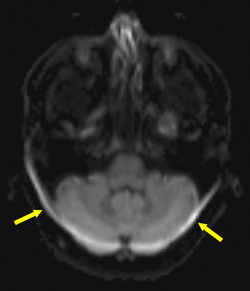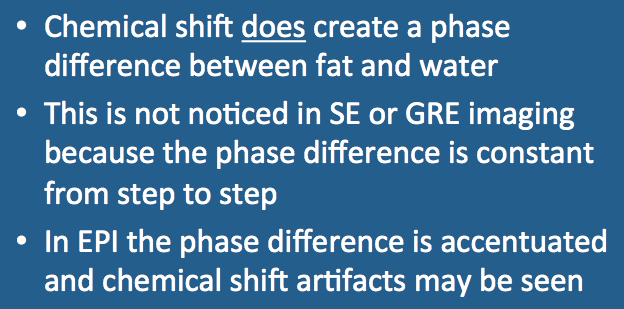It is indeed true that the chemical shift between water and fat protons produces both a frequency shift and a phase shift between the two species. In routine spin-warp imaging, however, the resulting extra phase of fat protons relative to water protons does not accumulate from one phase-encoding step to the next. The differential phase shift between water and fat is therefore constant at a given location between successive phase-encoding steps. Since the Fourier transform takes into account the phase difference in assigning spatial location to a signal in this direction, no water-fat misregistration will occur along the phase-encoding axis in routine spin-echo or gradient-echo imaging.
 EPI image with chemical shift
EPI image with chemical shiftartifact in PE direction (↑)
In echo-planar imaging (EPI) with Cartesian sampling, however, the opposite phenomenon occurs. Here, chemical-shift artifacts are minimal in the frequency-encode direction but may be extremely large in the phase-encode direction! The reason for this difference between spin-warp and echo-planar techniques lies in the way data is collected in the latter.
In EPI all the lines of raw data are collected immediately following a single RF excitation. The bandwidth per pixel in the frequency-encode direction is relatively large (i.e., on the order of 1500 Hz), so that chemical-shift artifacts are not noticeable. In the phase-encode direction, however, the bandwidth per pixel is extremely small (i.e., on the order of 10 Hz), since all the phase-encode lines are acquired in a time frame on the order of 100 msec. At 1.5T the fat/water chemical shift is about 220 Hz, and this low bandwidth in the phase-encode direction is translated into a noticeable artifact that can be up to 1-3 cm in width (depending on parameters chosen). Special corrections and modifications to the echo-planar technique must be made to minimize the fat signal and eliminate this artifact.
In EPI all the lines of raw data are collected immediately following a single RF excitation. The bandwidth per pixel in the frequency-encode direction is relatively large (i.e., on the order of 1500 Hz), so that chemical-shift artifacts are not noticeable. In the phase-encode direction, however, the bandwidth per pixel is extremely small (i.e., on the order of 10 Hz), since all the phase-encode lines are acquired in a time frame on the order of 100 msec. At 1.5T the fat/water chemical shift is about 220 Hz, and this low bandwidth in the phase-encode direction is translated into a noticeable artifact that can be up to 1-3 cm in width (depending on parameters chosen). Special corrections and modifications to the echo-planar technique must be made to minimize the fat signal and eliminate this artifact.
Advanced Discussion (show/hide)»
No supplementary material yet. Check back soon!
References
Jezzard P, Balaban RS. Correction for geometric distortion in echo planar images from Bo field variations. Magn Reson Med 1995;34:65-73.
Jezzard P, Balaban RS. Correction for geometric distortion in echo planar images from Bo field variations. Magn Reson Med 1995;34:65-73.
Related Questions
What is a chemical-shift artifact?
What is a chemical-shift artifact?
